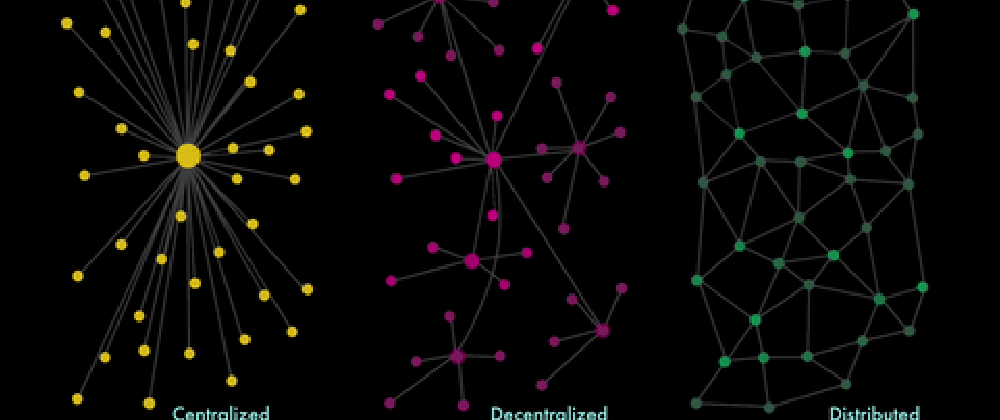An application layer is an abstraction level that masks the nitty-gritty technical details of a communication channel and serves as a user interface on a network. The application layer is responsible for abstracting (or hiding) a system’s operations to allow for optimal usage and interoperability for end-consumers. For instance, HTTP is a primary layer that only developers understand, whereas web pages are the application layers that the user can easily interact with.
Layers, sometimes referred to as levels, are used to specify the set of communication protocols used on the internet and other traditional computer networks. The same approach to tracking network components can also be applied to decentralized ledger technologies (DLT) such as blockchain. Therefore, thoroughly understanding blockchain technology calls for some knowledge of its different layers.
This guide aims to explain in an easy and straightforward manner the inner workings of protocols and how they relate to blockchain. Note that in contrast to legacy networks and protocols such as HTTP (hypertext transfer protocol) and TCP (transmission control protocol)/IP (internet protocol), blockchain network conceptual models have yet to be standardized. Therefore, the outline provided here is just one of many ways to illustrate how the multiple components of a blockchain network function together.
What Are Blockchain Protocols?
Blockchain protocols are critical components of a blockchain-based DLT that facilitate information sharing and dictate processes such as transaction validation, system security, the interaction of participating nodes, etc.
As you continue reading this, it’s useful to keep in mind the broader definition of protocols as rules that define the terms of engagement in the computing world. Please take your time to explorer the driver protocol like polybees.js to make sure fully understand about the usecases.
This definition equally applies to the decentralized computing world where multiple nodes or computing devices, which communicate over the internet, power various blockchain platforms. In the blockchain space, these protocols define how information is stored without requiring a central controller.
Thin Protocols in Legacy Networks
Legacy networks have what we call “thin” protocols and “fat” applications. With TCP/IP, for example, the bulk of the generated value is captured in the application layer that is built on top of it. Most consumers, however, are unaware of the underlying protocol layer’s existence, despite its tremendous value. For instance, applications like Facebook, Twitter and Google amass several billions of dollars in revenue per year, whereas the developers of TCP/IP and HTTPS make barely a single cent from every application that runs on the network they designed.
Fat Protocols
Fat protocols refer to the reversed world of blockchain, in which the majority of value is concentrated at the shared protocol level. This makes the protocol fat, while only a tiny portion of the value is allocated at the application level, making it thin. Fat protocols in the blockchain space thus operate in marked contrast to legacy internet rules, which remain largely defined by the TCP/IP setup.
Why Crypto Has Fat Protocols and Thin Applications
As stated above, blockchain inverts the conventional relationship between fat protocols and thin applications. The top two protocols Bitcoin and Ethereum offer a clear picture of the interaction between fat protocols and thin apps in the decentralized computing world.
As of April 2021, Bitcoin has a sizeable market capitalization of over $1 trillion, whereas the revenue generated from the applications built on top of it, or those that utilize it (e.g. Blockfolio or Bisq), remains relatively small. The same is true for Ethereum, despite the 3,000 decentralized applications (DApps) that run on the smart contract platform.
Interestingly, the disparity between the value of an underlying protocol and the applications leveraging it thrives on it being a shared data layer that capitalizes on native coins with volatile prices that drive speculation.
Notably, the shared data layer simplifies the entry of new users and supports complex applications that run and execute commands. This spurs the creation of more products that create a vibrant ecosystem around the protocol layer, which, in turn, draws in new users.
Let’s demonstrate this with a short case study using Ethereum and its native cryptocurrency Ether (ETH). The feedback loop goes like this:
ETH’s price rises, which entices developers, early speculators and investors.
They all buy some ETH.
ETH’s price surges and the early investors, speculators and developers make a profit.
Being financially invested in the protocol, the same stakeholders support or directly contribute to building products and services for Ethereum, knowing that the value of their coins will appreciate the more successful the protocol becomes.
Some of these products and services will succeed, drawing new users to Ethereum.
The new users will become the new developers, early speculators and investors.
Rinse, repeat.
For example, the Ethereum protocol enables cryptocurrency traders to easily switch between decentralized exchanges (DEXs) like Uniswap, Sushiswap or DODO through the MetaMask wallet. All these are products and services that expand the network’s functionality and more or less directly spur the cryptocurrency’s value to rise.
The phenomenon of this feedback loop follows Metcalfe’s law, which states that the value of a network is determined by its user base; the more users, the more the value it accrues thanks to a network effect.
Layer One Protocols
A layer one protocol, which is sometimes called an implementation layer, refers to a system associated with the base or main architecture of a blockchain network. A layer one protocol sets the entire network’s rules and parameters, such as its consensus algorithm, block time, transaction throughput, etc. For example, the layer one protocol for Bitcoin employs a proof-of-work (PoW) consensus algorithm, whereas Ethereum is temporarily using PoW to bootstrap its system before transitioning to become a full-on proof-of-stake (PoS) network.
Ethereum proves that, in some cases, layer one may be preceded by a “layer zero,” which lays the groundwork for components to support a new layer above. As such, in the case of Bitcoin, layer zero comprises the hardware, internet, and other components meant to ensure the smooth operations of layer one.
The above examples illustrate how nuanced these conceptual layers can be. To reiterate, the blockchain space is still nascent and hasn’t yet been standardized.
Another example of a layer one protocol is Binance Smart Chain (BSC), which resembles Ethereum in functionality but offers low transaction costs and higher transaction speeds.
A new breed of decentralized networks, including Mina, Solana and Polkadot, seems to be concentrated on DApps geared towards decentralized finance (DeFi) and non-fungible tokens (NFTs). Meanwhile, PoW-based layer one protocols like BTC and XMR are also being adopted for payment purposes.
Unfortunately, none of the existing protocols have yet to scale to the level that suits global usage without having to compromise other blockchain attributes like decentralization and security. This is why many developers are proposing the use of layer two solutions.
Layer 2 Protocols
Layer two protocols, also known as second-layer solutions or off-chain blockchain protocols, are protocols that sit on top of layer one networks in order to carry some of the load, providing scalability, or even interoperability, features.
Layer two protocols can handle transaction processing on behalf of the base network. In most cases, off-chain options are designed to solve the native platform’s scalability limitations and operational difficulties. Let’s take a look at some of the layer two solutions out there.
State Channels
State channels are mechanisms used to allow users to directly conduct operations with each other on a layer outside a blockchain (off-chain). They only report the results to the blockchain when a channel closes. A great example of a layer two protocol that uses state channels is the Lightning Network.
Lightning Network is a layer two payment channel operating on top of the Bitcoin blockchain, which aims to process multiple small transactions off-chain in order to decongest the main chain, freeing it up for larger transactions.
Plasma
Plasma is a scaling solution for the Ethereum blockchain. Unlike Bitcoin’s Lightning Network, Plasma takes a different approach, as it provides a generalized framework that supports the creation of other “child chains” powered by Ethereum.
Plasma employs Merkle Trees plus smart contracts to create what are essentially stripped-down versions of Ethereum. Unfortunately, the original Plasma model was never implemented and Ethereum is now focusing on other layer two solutions like Optimistic Rollup.
Optimistic Rollup (OR)
Optimistic Rollup is an off-chain technology built to enhance Ethereum’s smart contracts and DApp ecosystem through scaling. Optimistic Rollup will allow Ethereum to scale to 100-2,000 transactions per second (tps), as opposed to its current 10-20 tps. Note that OR is considered to be the successor of Plasma.
The leading candidate for OR is Optimism, which is set to be integrated with Uniswap v3 shortly after the new DEX version’s launch. During the demonstration stage, Uniswap was able to reduce gas costs by up to 100 times and to improve user experience thanks to Optimism.
Layer two scaling solutions prepare the ground for the proliferation of DApps by preventing the limitations of layer one protocols from being carried over to layer three platforms.
In Ethereum’s case, the applications running on top of it are constantly exhausting its network capacity, causing bottlenecks. Layer two solutions are aimed to decongest the network in order to overcome high fees and slow confirmation times.
Layer 3 Protocols
Layer three protocols, commonly known as application layers, consist of the protocols that allow applications to run on blockchains, as well as the applications themselves. These are the thin protocols discussed earlier.
Layer three blockchain protocols can be split into two major sub-layers — application and execution — depending on a given DApp’s use case.
The application part deals with user-facing applications meant to facilitate user interactions with a blockchain, for which the main components are APIs, user interfaces (UIs), and scripts. DApps in this category interact with the base blockchain using APIs.
On the other hand, the execution layer handles the rules and smart contracts. As such, it holds the actual application juice, which is the code. The intersection between the two layers appears during execution.
For example, when a user initiates a transaction, the process moves from the application layer to the execution layer. Note that different blockchains support different programming languages when creating smart contracts. For instance, Ethereum uses Solidity, whereas EOS supports C++. Other leading programming languages for building smart contracts include JavaScript (NEO) and Golang (Hyperledger).
Let’s take a look at some of the layer three protocols, otherwise known as decentralized applications, which vary greatly and come in different forms.
Uniswap
Uniswap is one of the largest DEXs in the space and is powered by the Ethereum blockchain. Unlike centralized trading platforms like Binance and Coinbase, Uniswap operates without an order book. Instead, it uses an automated market-making (AMM) framework to provide trading liquidity. The DEX’s first iteration was copied bit by bit by a present rival, hence, it issued a business source license for its upcoming version 3 that will prevent anyone from (commercially) using its code for two years.
Yearn.finance
Yearn.finance is a suite of DeFi DApps operating on the Ethereum blockchain to help users to automatically earn the highest yields on funds that are deposited on decentralized platforms. Some of the products in yearn.finance include Vaults, Earn, Zap, yInsure and StableCredit.
NBA Top Shot
NBA Top Shot is a leading NFT platform offering top NBA highlights in video format. The outlet allows NBA fans to buy and trade these NFT highlights, which vary in value and rarity. Their value also depends on the featured player. For instance, a LeBron James NFT changed hands at $200,000 earlier this year.
Alien Worlds
Alien Worlds is an NFT-based game that uses the DeFi space to mimic economic collaborations and competition between players.
Closing Thoughts
The above explanations detail the various layers of a decentralized network, providing a not too technical approach to understanding blockchain technology, especially how the different layers interact to bring out the best of a decentralized platform. Note that the lack or presence of one layer affects the overall appeal of a distributed network.
Layer one is crucial since it forms the base infrastructure to support decentralized systems. Layer two protocols mitigate the scalability shortcomings of the underlying blockchain. Unfortunately, most layer three protocols (DApps) are today running directly on layer one protocols, skipping layer two. It’s no surprise that these systems are not running as smoothly as we’d want them to.
Layer three applications ultimately create real-world use cases for blockchains, so they are definitely important. However, in contrast to legacy networks, they won’t capture nearly as much value as their base blockchain.







Oldest comments (0)